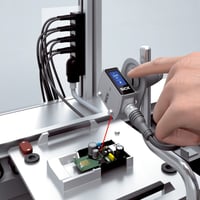From CPV to VTUX: Migration Strategies for Upgrading Your Pneumatic Systems
Staying competitive means keeping your pneumatic systems at the cutting edge of technology. If you're currently running Festo's established CPV, MPA-L, MPA-S, or VTUG valve terminals, you might be wondering about the benefits and process of upgrading to the new VTUX platform. Let's explore a practical approach to this migration.
Why Consider an Upgrade?
The VTUX represents a significant evolution in valve terminal technology, combining the best features of previous generations while introducing new capabilities. Most notably, the VTUX delivers exceptional flow rates up to 730 l/min with a single valve size that fits all applications. This means you can standardize on one valve type, simplifying inventory and maintenance.
The VTUX's 10mm valve delivers equivalent or better flow rates than both the CPV-10 and CPV-14, all while providing more consistent force in a more compact package. You'll also gain the ability to arrange modules as needed thanks to internal communication flexibility.
Planning Your Migration
Start by evaluating your current system's performance limitations. Are you experiencing bottlenecks in cycle time? Do you need better communication with your control systems? Perhaps you're looking to reduce compressed air consumption or adopt a more decentralized architecture. Understanding these pain points helps prioritize which systems to upgrade first.
Next, conduct a compatibility assessment. The good news is that Festo designed the VTUX with compatibility in mind. As they state in their documentation, "the existing and new valve terminal worlds are compatible, regardless of which valve terminal world you are using." This means your migration can be phased rather than requiring a complete system overhaul.
Implementation Strategies
A phased migration often works best. Consider starting with a non-critical application to test the VTUX's performance in your specific environment. This allows your team to become familiar with the new platform while minimizing risk.
When you're ready for wider implementation, the modularity of VTUX becomes a significant advantage. You can standardize on the 10mm valve size across applications that previously required different valve dimensions. This simplifies inventory and maintenance training.
For installations using multiple valve terminals, the new AP communication system allows for simpler connectivity, even over distances up to 50 meters. This might enable you to consolidate control functions or adopt a more optimal architecture than was previously possible.
Beyond Hardware: Leveraging New Capabilities
The VTUX isn't just about improved flow rates—it's a platform designed for the future of digitized production. Once upgraded, explore how the AP-I and AP-A communication systems can streamline your operation. The faster data rates (up to 200 MBaud) and cycle times (as quick as 250 μs) might allow for performance optimizations beyond what was possible with your previous system.
The lightweight construction also opens new possibilities for mounting the valve terminal directly on moving components like robot arms or gantries, potentially simplifying your pneumatic layout and improving response times.
Future-Ready, Pneumatics Start Here
The most compelling reason to migrate to VTUX is future-proofing. As Festo puts it, the VTUX is "open for today's and future innovations." Your investment now sets you up for easier integration of upcoming technologies without another major system change.
With thoughtful planning and a phased approach, upgrading from CPV, MPA, or VTUG to the VTUX platform can be a smooth process that yields immediate performance benefits while positioning your systems for the changing demands of modern manufacturing.
Want to learn more about migrating to VTUX?
Contact marketing@eandm.com for a personalized assessment of your system and a demonstration of how the VTUX can enhance your specific applications.



.png?height=200&name=Screenshot%202025-06-12%20093003%20(1).png)